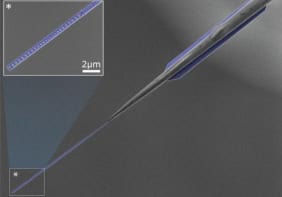Carbon nanotubes are relatively easy to grow, but sorting these tiny tubes according to their electronic properties is a time consuming and costly task. Now, however, researchers in the US have invented a way of isolating different types of nanotube by mixing them with DNA. Although the technique is currently too expensive to be commercially viable, the scientists believe that it could someday be used to create high-quality carbon nanotubes for electronics and other applications.
A single-walled carbon nanotube (SWNT) can be thought of as a sheet of carbon just one atom thick that has been rolled up into a tube with a diameter of about 1 nm. The atoms in the sheet are arranged in a hexagonal lattice and the relative orientation of the lattice to the axis of the tube — what is known as its “chirality” — dictates whether the tube is a metal or a semiconductor. Tubes that are about 1 nm in diameter have about 25 different possible chiralities.
The diverse properties of SWNTs have allowed researchers to build simple electronic devices such as transistors from these tiny tubes. Indeed, some scientists even believe that SWNTs could replace silicon in future electronic devices because they are tiny, but can still carry large amounts of current. An important challenge however, is that it has not yet proved possible to make just one type of SWNT at a time. Instead, mixtures of tubes with different chiralities have to be painstakingly sorted using expensive processes that are not commercially viable.
DNA to the rescue
Now, though, Ming Zheng and colleagues at the chemical firm Dupont have separated SWNTs by chirality by mixing them with a solution of DNA and then using a standard chemical separation process known as liquid chromatography. This technique involves sending molecules through a tube that is packed with beads. As every type of molecule reacts differently with the surface of the beads, the system can be adjusted so that one particular type of molecule travels rapidly through the tube, while the others lag behind.
The new technique involves mixing the SWNTs with a particular DNA sequence, which coats the surface of the nanotubes to form large, hybrid molecules. Zheng and colleagues found that the chromatography system could be adjusted so that hybrids containing SWNTs of a specific chirality are first through the tube — and could therefore be isolated. The DNA is then removed from the SWNTs, leaving a relatively pure sample.
SWNTs of a different chirality can be selected by using a different DNA sequence — with the team identifying a total of 12 DNA–SWNT combinations. This was not an easy task because they began with 1060 possible DNA sequences, which were winnowed down to 350 candidates using a series of chemical and structural criteria.
Chiral purity
Zheng’s team found, using an optical-absorption technique, that the chiral purity of the sorted nanotubes was between 70–90% (with an uncertainty of ±10%) depending on which chirality was targeted. When the electronic properties of one group of tubes with 90% ±10% purity were tested by using them to make field-effect transistors, 99% of them were semiconductors.
While this success rate suggests that the technique could be used commercially, Zheng told physicsworld.com that the high cost of making the DNA sequences means that it is not commercially viable. However, he believes that low-cost DNA sequences could become commercially available in the future if there is a demand from the nanoelectronics industry.
Another shortcoming of Zheng’s technique, according to Mark Hersham at Northwestern University, is that it is better at isolating semiconductor SWNTs than it is at finding metal nanotubes — something that the Dupont team says it doesn’t fully understand. “Further work is required to isolate both types equally using DNA”, says Hersham.
The research is published in the journal Nature .




